Chapter 4: Creating Safe Outdoor Environments
Importance of Impact Absorbing Surfaces
Outdoor Equipment – Safety Considerations
Using Zones
Age Appropriateness equipment
Playground Hazards
Riding Toys
Helmets
Keeping Children Safe by Monitoring
Active Supervision
Other Considerations for Outdoor Safety
Sun Safety
Hydration
Weather
Protecting Children from Heat-Related Illness
Protecting Children from Cold Weather
Protecting Children from Insects
Water Safety
Preventing Poisoning Outdoors
Safely Storing Outdoor Toys and Materials
Pedestrian Safety
Motor Vehicle Safety
Safely Transporting Children
Car Seats
Tips for Excursions
Summary
Resources
References
Chapter 4 Learning Objectives
By the end of this chapter, you should be able to:
- Illustrate why outdoor play is essential to health and well-being.
- Describe elements of a safe outdoor play space.
- Recognize the importance of impact-absorbing surfacing under equipment.
- Explain what use zones are.
- List age-appropriate outdoor play equipment for each age group.
- Identify hazards on outdoor play equipment
- Develop a safety checklist to monitor the safety of the outdoor space.
- Outline ways to protect children from the weather, the sun, insects, drowning, and poisoning.
- Discuss how to keep children safe as pedestrians, in motor vehicles, and while on field trips.
Introduction
There are countless benefits to outdoor play for children. Research shows that children who play outside regularly have healthier body weight, improved vision, and immune function, reduced stress, better sleep, and improved motor skills. There are substantial immediate and long-term health consequences for children who aren’t able to play outside or get enough physical activity such as increased obesity and chronic diseases. The research also shows that children who play outdoors have increased school readiness because outdoor play contributes to better social skills such as cooperation, increased attention span, improved school attendance, and improved brain development and cognition. Physical activity plays a critical role in supporting health and learning.
Educators need to be aware of the benefits of outdoor learning as they relate to overall health and school readiness so that they remember that the outdoor environment is an essential extension of the indoor environment. All the learning that takes place indoors can also take place outdoors. Anything programs do indoors can have an outdoor component.
Consider for a moment how a program can increase the benefits of outdoor play while also minimizing injury. Reducing risk does not mean limiting play equipment or enforcing rules that restrict children’s ability to move and explore their environment. An ideal playground is one that encourages children to challenge themselves while also posing little risk of injury. In fact, studies show that playgrounds that are high challenge but low risk are the very best at promoting the goals of outdoor learning. Children get more physical activity, develop better physical, cognitive, and social skills and are happier and more resilient when their outdoor play environment is challenging and safe.[1]
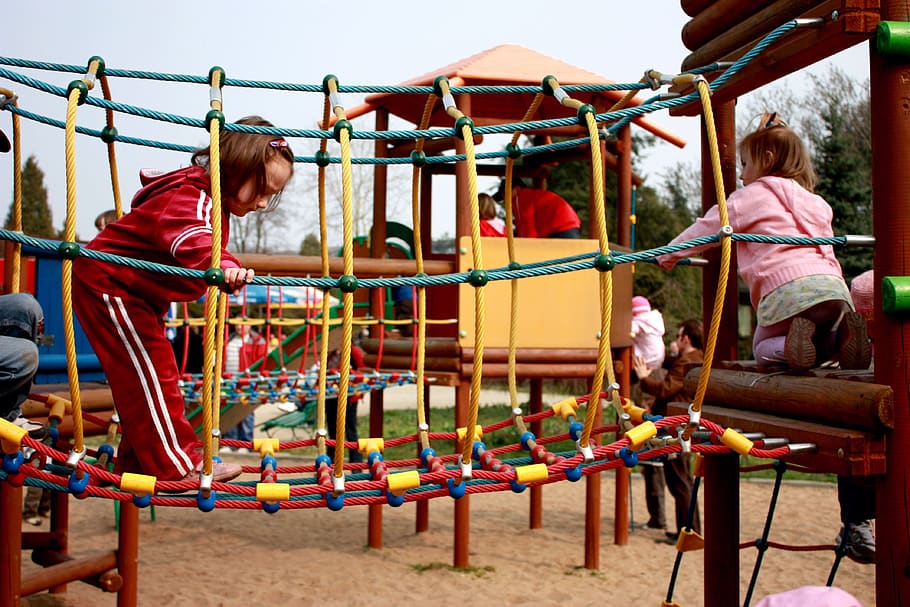
Playground Safety
When designing an outdoor space for children, it is critical to reduce the risk of injury while increasing the challenge. The first step is knowing what aspects of the actual learning environment are most likely to cause injuries.
Falls from, into, or on equipment are the most common cause of injury. Falls are most likely to occur on equipment that is not appropriate for the age and development of the children. Injuries are most likely to occur when the surface on which a child falls is not sufficiently shock-absorbing. The play equipment that is associated with the most injuries includes climbers, such as monkey bars or overhead ladders, swings, and slides. About 85% of all playground injuries occur on these three pieces of equipment. The most common cause of death on playgrounds is strangulation.
It’s important to understand that injuries are not accidents. Most injuries are predictable and preventable. Programs can take steps to prevent serious injuries by
- choosing developmentally appropriate play equipment to ensure children do not fall from a high level and the challenges on the playground are matched with their ability.
- installing proper surfacing to minimize the severity of an injury if a child does fall.
- providing intentional and active supervision by maintaining close proximity to children, especially in places that are high risk for injury from a fall such as the slide or monkey bars).
- encouraging safe behaviours by introducing safety habits to children.
Reinforcing these safe behaviours in an early care and education program provides lifelong lessons about safety and injury prevention. As consultants, you can work with your program and teachers to predict and prevent many injuries and allow children to play.
Designing for Safety
Safe outdoor play space starts with selecting and correctly installing safe and age and developmentally-appropriate structures. The play space design should not be a hazard and should separate active play areas such as swings and slides from quieter activities such as the sandbox, nature-based learning, and dramatic play areas. The only equipment that is manufactured for public playgrounds or childcare facilities should be used. So, home playground equipment like Little Tykes brand or plastic sets that home use at local stores are not appropriate.
Regulations and Standards
In Saskatchewan, regulations for playgrounds and outdoor play areas are outlined in The Child Care Regulations 2015, and the Saskatchewan Child Care Licensee Manual.
Secotion 59: Physical Envrionment s, Faclities and Equipment Outdoor play area.
(1) The licensee of a centre must provide a safe outdoor play area of seven square metres per licensed child care space.
(2) Unless otherwise provided in the licence, at least half of the outdoor play area required by subsection (1) must be adjacent to the centre and the remainder must be within walking distance of the centre, determined in relation to the youngest age category for which the centre is licensed. 22 May 2015 cC-7.31 Reg 1 s59.
CCR- Section 59 Physical Environments, Facilities and Equipment Outdoor Play area

The Canadian Standards Association (CSA) outlines recommendations for Playground Safety (CSA Z614-20) is a voluntary standard around materials, installation, strength of the equipment, surfacing, inspection, maintenance, performance requirements, access to the playground, play space layout and specifications for each type of equipment. (CSA, 2020).[3]
Policies and procedures should be created to establish regular maintenance and inspection schedules. Play equipment should comply with the CSA standards for playground equipment and surfacing (CSA Z614-20), as well as be inspected on a regular basis by a certified playground inspector using CSA standards.
Daily inspections should also be done by staff daily, weekly and monthly. Things to look for during your informal inspections include[4]:
- Broken equipment
- Loose bolts
- Missing bolts, screws, nails or other fasteners
- Cracks or breaks in plastic equipment
- Loose anchoring
- Insect damage
- User-modified equipment
- Vandalism
- Worn, loose, missing or damaged parts
- Rusted metal
- Wood rot or splintering
- Open S-hooks
- Protruding bolts
- Sharp edges
- Peeling paint
Importance of Impact Absorbing Surfaces
Since falls from play equipment are the number one cause of playground injuries that result in hospital visits, the area under and around the play equipment, also known as the encroachment area, must have a surface that cushions a child’s fall. According to the Saskatchewan Prevention Institute, the surface of the encroachment area should be 15-30 cm (6-12 inches) deep and is determined by the fall height, which is the highest-designed play surface and the protective surface. The encroachment area should also extend 1.8 m (6 feet) around each piece of equipment. For swings, it would be twice the height from the top of the swing structure to the swing seat[5].
There are two types of appropriate, impact-absorbing playground surfaces, unitary and loose-fill.
Unitary material
Unitary material such as tiles, mats, or a rubber surface is engineered to be sufficiently shock-absorbing.[6] There are many options. Suppose a program wants to use a unitary surface. In that case, it’s important that one is chosen for the appropriate height of equipment and that the manufacturer’s instructions are followed closely (and some require professional installation).[7]


Loose-fill material
Loose fill surfaces, such as sand, pea gravel, shredded rubber, or engineered wood fibre and mulch, when installed correctly, will also safely cushion a child’s fall.[10]
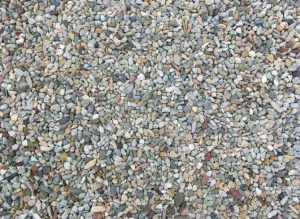



Choosing protective surface
There isn’t a single best surface to use on playgrounds. The best surface is the one that:
- the early learning program can afford
- the early learning program is able to appropriately maintain
- meets the needs of the children based on their age
- is workable given the climate where the early learning program is located
- consistently meets the standard for depth that is based on the height of the equipment on the playground.
Surfaces such as asphalt, cement, dirt, and grass, are not acceptable surfaces. Grass is not an impact-absorbing surface. If a child falls onto grass, they are far more likely to get hurt than they are if they fall onto an appropriate impact-absorbing surface.
Programs need to consider how data can help them make informed decisions about which surfacing is best for a particular playground. It’s important to think about who will be using the space and for what.
- Some surfaces like pea gravel are not an appropriate choice for infants and toddlers who might put it in their mouths since it can be a choking hazard.
- Few of the loose fill materials are accessible for wheelchair users without significant accommodation, such as a special wheelchair. Engineered wood fibres provide a little bit better access, but solid or unitary materials are best if you have children on the playground with mobility impairments.
- Will the staff be able to maintain the playground surface? All loose fill surfacing required daily raking to maintain depth.
- Consider how tall the equipment is because sand and pea gravel can’t be used at fall heights that are greater than four to five feet.
- The climate is also an important consideration. Factor in temperature, wind conditions, and precipitation, because they all impact the surface materials you choose.
- Sand can harden when frozen.
- Artificial surfaces can get really hot, in fact, hot enough to cause burns when they’re exposed to direct sunlight.
- Loose fill material, with the exception of rubber mulch, compresses about 25 percent over time due to use and weathering.
The protective surfacing has to extend to the full-use zone, which is the area under and around equipment where children might fall as a playground surface can’t protect a child who falls onto a hard object such as a tricycle instead of onto the protective surface.[15]
|
Pause to Reflect
|
Outdoor Equipment – Safety Consideration
Use Zones
The use zone is the space that encompasses the activity/piece of equipment and the area around that activity/equipment that will keep children from colliding and provides enough separation between different pieces of equipment and types of play. It is also sometimes referred to as a fall zone. The use zone should be free of movable hazards like trikes and toys, rocks, and groups of children who might cluster and fixed hazards such as benches.
Use zones vary depending on the size and the type of equipment. For most stationary equipment on the playground, the use zone should extend six feet in all directions (see Figure 4.3).[16] Equipment that is taller than 30 inches should be at least nine feet from other pieces of equipment. And the use zone for swings should extend from the front and rear of the swings twice the height of the swing (see Figure 4.4).[17]
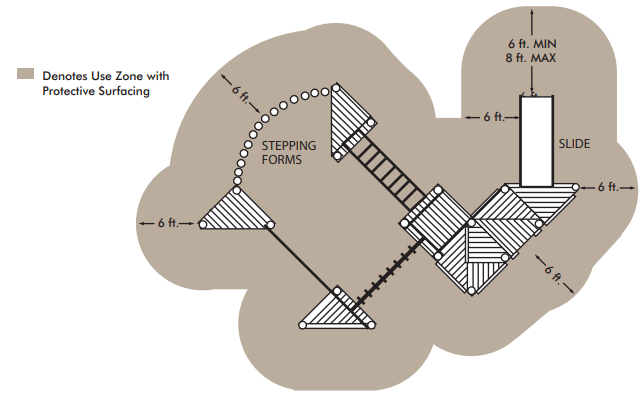

Age Appropriate Equipment
Age-appropriate equipment provides children with opportunities to safely practice gross motor skills without putting them at risk for unnecessary injury. This takes us back to the notion of creating playgrounds that are high challenge but low risk.
Children are less likely to fall when equipment is only used with the age group for which it is designed. Age groups are typically divided into 3 age categories 6 to 23 months of age, 2 to 5 years of age(preschoolers), and 5 to 12 years of age (School age). So, any equipment that is marked for 5 to 12 years of age is not acceptable on a preschool playground.[20]
Table 4.4 – Age-Appropriate Equipment[21]
| Age | Age Appropriate Equipment |
| 6 to 23 months
|
· Equipment under 32 inches high
· ramps · single-file stepladders · spring rockers · slides · bucket swings |
| 2 to 5 years
|
· Climbers up to 60 inches in height
· rung ladders · belt and tire swings · balance beams |
| 5 to 12 years
|
· arch climbers
· flexible climbers · overhead rings and ladders · poles |
| Not appropriate for any age
|
· trampolines
· swinging gates · climbing ropes that are not secured at both ends · animal figure swings · multiple occupancy swings · rope swings · trapeze bars |
Playground Hazards
Gaps in equipment such as the space between the platform and the top of the slide or hooks can entangle clothing or entrap body parts, causing trips, falls, or strangulation. Head entrapment into gaps that are large enough for a child’s body to pass through (bigger than 3.5 inches) but too small for a child’s head to pass through (smaller than 9 inches) can injure a child’s neck or choke a child.
Equipment that spins and moves such as steering wheels or springs on rockers can pinch, cut, or crush fingers or other body parts. So, you want to make sure that any equipment that spins or moves is not accessible for little fingers. Broken parts or improperly installed equipment can cause injuries if the equipment tips over, breaks during use, or has sharp or loose parts that can cut or entrap a child. And railings to prevent falls can break if bolts are loose. See Table 4.5 for examples of dangers to watch for on playgrounds.
Table 4.5 – Playground Hazards[22]
| Playground Hazards[23] | |
 Example of a hazardous projection that increases in diameter from plane of initial surface and forms an entanglement hazard and may also be an impalement hazard. Example of a hazardous projection that increases in diameter from plane of initial surface and forms an entanglement hazard and may also be an impalement hazard.
|
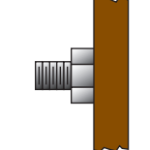
Example of a hazardous projection that extends more than 2 threads beyond the nut and forms an impalement/laceration hazard and may also be an entanglement hazard. |

If the distance between the platform and bottom of the railing is between 3.5 and 9 inches, it is an entrapment hazard. |
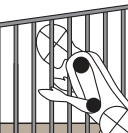 If the distance between an opening (such as this railing) is between 3.5 and 9 inches, it is an entrapment hazard. If the distance between an opening (such as this railing) is between 3.5 and 9 inches, it is an entrapment hazard. |
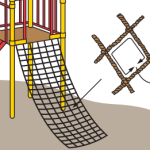
Entrapment hazard: when the perimeter of the net openings is between 17 inches and 28 inches |

Strings on children’s clothing can create entanglement hazards and hood drawstrings can create strangulation hazards. |
Pause to Reflect

Think of that playground again. Did it offer adequate use zones around the different pieces of equipment? Was the equipment used by the appropriate age groups (or did older children play on equipment designed for young children or vice versa)? How well did it protect children from the hazards mentioned (trips and falls, entrapment, impalement, entanglement, or strangulation)?
Riding Toys
All children older than age 1 should wear properly fitted and approved helmets when they are riding toys with wheels or using any wheeled equipment. Helmets should be removed as soon as children stop riding the wheeled toys or using the equipment. Approved helmets should meet the standards of CSA Canadian Standards Association[24] and should pass the three-point check for a proper fit.
Helmets
Use the 2-V-1 rule to ensure a proper fit
Parachute recommends the 2-V-1 method:
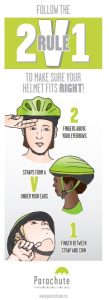
- The helmet should cover the top of the forehead and should rest about 2 fingers’ width above the eyebrows. Do not sling the helmet back to expose the forehead—it should sit level at the front and back and not be tilted back on an angle.
- Straps should meet snugly in a V-shape just below the ears. Buckles on the side straps should fit right under the ear.
- One finger should fit between the chin and chin straps. It should not shift around more than an inch in any direction, but should still allow the child to drink or shout.
- If the head is shaken, the helmet should not move from front to back, or side to side.[25]
Video – Brain Waves – Helmet Fitting Activity
“Helmets provide the best protection against head and brain injury, whether [the] child is riding a bike, scooter or skateboard, or using skates. However, a helmet will only protect when it fits well.”[26]
Below is a video created by Parachute a Canadian national organization dedicated to injury prevention (Parachute.ca). It outlines the proper ways to fit a helmet [27].
Tips for Safer Helmet Use
Parachute also gives the following suggestions for safer helmet use:
- Look for a helmet that fits comfortably and meets safety standards labelling. Helmets sold in Canada are certified by CSA (Canadian Standards Association), CPSC, Snell, or ASTM (American Society for Testing and Materials).
- Your child should not wear a baseball hat or anything else underneath the helmet.
- Avoid putting stickers on a helmet as the solvents in the adhesive can weaken the outer shell.
- Helmets should be replaced at least every five years, even if you don’t see any damage.
- Do not use second-hand helmets, since you cannot know whether they’ve been impacted or in a crash.
- Check your provincial/territorial legislation on helmet use [PDF].
- Get kids (and yourself!) into the habit of wearing a helmet each time they head out, whether they’re on a tricycle, scooter, or balance bike.[28]
Keeping Children Safe by Monitoring
Early care and education programs need to develop a routine inspection process to identify and prevent hazards. Outdoor play spaces are subject to a lot of wear and tear from use, sometimes misuse, from weather conditions. So, even if a program has correctly installed safe and age and developmentally-appropriate equipment, it still requires regular inspections and maintenance.
The outdoor space, including the playground, should be inspected using checklists such as the ones in Appendix E. It should be inspected upon initial installment.
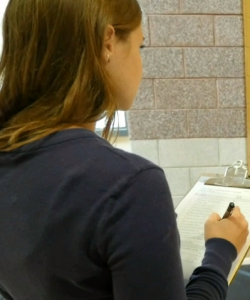
It should also be inspected daily to identify hazards that may have appeared suddenly. It will also alert staff to any pieces of equipment that may have broken or become worn since last being used. Some general items to include in a daily inspection may include ensuring that
- any broken equipment is removed from children’s access or repaired
- the playground is free from
- glass,
- needles,
- cigarette butts,
- animal feces,
- trash
- standing water
- trip hazards
- the use zones are free from obstacles that may have been moved into them, such as tricycles or movable benches
- displaced loose fill surfacing is raked
- platforms and pads are free of sand and surfacing debris and any tripping hazards
- the area is scanned for
- o insects or insect nests
- o broken equipment
- o weather-related hazards such as hot surface or equipment, ice, or other damage from weather
A monthly inspection would include:
- checking for loose or missing hardware, checking
- inspecting equipment for broken parts, splinters, rust, or sharp edges,
- replenishing loose fill surfacing if needed, and
- examining vegetation for hazardous or poisonous plants.
There has to be a system in place to conduct inspections and then respond in a timely manner when something is identified. It’s too common for someone to notice a hazard but to forget to report it or for somebody to report a hazard but then people forget to follow through to correct it. Many checklists include space for writing down a corrective action plan. Once the hazard is identified the person completing the form will write down what steps should be taken to correct the problem, including identifying who will fix it, what needs to be done, and when it will be done. The process should also include a system to check that the problem was fixed in a timely manner.
A record of any injury reported to have occurred on the playground should also trigger an additional inspection of that piece of equipment (this was previously discussed in Chapter 2). This will help identify potential hazards or dangerous design features that should be corrected.
Active Supervision
The most important tool for reducing playground injuries is active supervision (which is also addressed in Chapter 2). Early childhood educators should be actively supervising children at all times. Active supervision is a specific child supervision technique that requires focused attention and intentional observation of children at all times. Active supervision includes six basic strategies.
- Plan and set up the environment to ensure clear sightlines and easy access to the children and the equipment at all times while they’re out on the playground.
- Teachers are positioned among the children in their care, changing positions as needed so that they can keep an eye on the children.
- They are communicating about which children they’re observing and any issues that divert their attention so that they know other teachers are taking up the slack and watching the other children.
- Teachers are watching, counting, and listening to children at all times
- They also use their knowledge of each child’s development and abilities to anticipate what a child might do or to anticipate areas on the playground where a child might need some additional support.
- And if needed, they get involved and they redirect children when necessary or they provide that additional support if needed.[30]
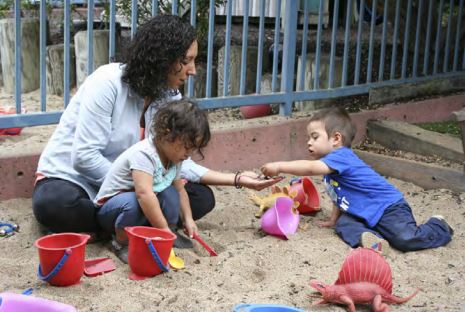
Let’s revisit the Outdoor Active Supervision video from Chapter 2.
Other Safety Considerations for the Outdoors
In addition to designing and maintaining a safe playground for children, you also need to monitor environmental factors such as weather, the sun, insects, animals, poisonous plants or materials, and water.[31]
Sun Safety
Children need protection from the sun’s harmful ultraviolet (UV) rays whenever they’re outdoors. Shade and sunscreen protect children from sun exposure and can help reduce the risk of some skin cancers.
According to the Centers for Disease Control and Prevention (CDC), even a few major sunburns can increase the risk of skin cancer later in life. The Canadian Pediatric Society recommends the following guidelines regarding sun safety and the selection and application of sunscreen[32]:
- If possible, use play areas that provide some shade to help children stay cool.
- Protect infants under 6 months from direct sunlight by keeping them in a shady spot under a tree, umbrella, or stroller canopy.
- Limit children’s sun exposure between 10 a.m. and 2 p.m. when UV rays are the strongest.
- Encourage families to dress children in cool clothing such as lightweight cotton pants and long-sleeved shirts. A hat will help protect their face, ears, and the back of their neck.
- Obtain written permission from parents/ guardians of children 6 months and older to use sunscreen with a SPF 30(sun protection factor). Ask families to provide a “broad-spectrum” sunscreen to screen out both UVB and UVA rays.
- Remember to put sunblock on ears, nose, back of neck and lets and tops of feet.
- Apply sunscreen at least 30 minutes before going outdoors so it is absorbed into the skin. It will need to be reapplied every two hours if children are outside for more than an hour, and more frequently if they are playing in water.
- Each child should have their own labeled bottle of sunscreen.
- For children older than 6 months, apply sunscreen to all exposed areas, including children’s ears if they are wearing a cap instead of a hat.
- For children younger than 6 months, use sunscreen on small areas of the body, such as the face and the backs of the hands if protective clothing and shade are not available. Keep in mind that children under 6 months may end up rubbing it into their eyes and mouth, so use other forms of sun protection such as light clothing, sunshades etc. If you must use sunscreen use only a little of the exposed parts.
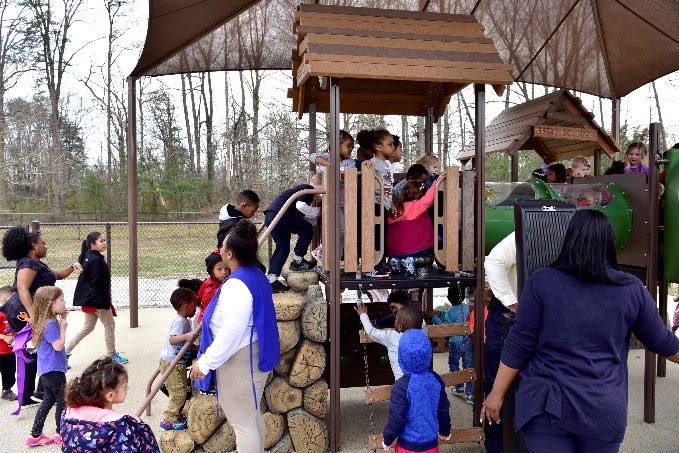
Hydration
Toddlers and preschool children cannot regulate their body temperatures well and need additional water when the weather is hot. Provide regularly scheduled water breaks to encourage all children to drink during active play, even if they don’t feel thirsty. Fluoridated water (bottled or from the faucet) can reduce the risk of early childhood caries, and is the best drink choice for young children in between meals. Each child should be provided their own cup or bottle. Staff may offer additional breast milk or formula to infants as water is not recommended, especially for infants younger than six months of age.[33]
Weather
Teachers should be aware of local weather conditions and monitor the temperature, humidity, and air quality. To stay up to date on current conditions:
- Check the Air Quality Index and limit play outdoors when there is poor air quality.
- Check the forecast for the UV Index to limit exposure to the sun on days when the Index is high.
- Check current and forecasted weather to be aware of the temperature and other weather conditions that may make the outdoors hazardous to children’s health.
Ever wonder about the Air Quality Health Index (AQHI) or Air Quality Index (AQI) and what it means for you and the children you will be working with? Watch the video below from the Weather Network [62]
Video – What Do Those Air Quality Numbers in Canada Actually Mean?
Ever wonder about the Air Quality Health Index (AQHI) or Air Quality Index (AQI) and what it means for you and the children you will be working with? Watch the video below from the Weather Network [62]
Below is a Humidix chart
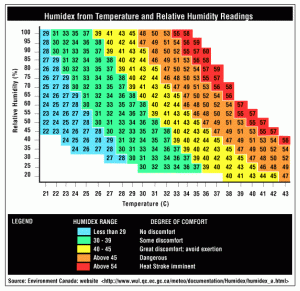
Protecting Children from Heat-Related Illness
Children’s bodies heat up three to five times faster than adults.[35] It’s important to help children during hot weather. Here are some tips from Environment Canada[36]
- Air conditioning should be provided when temperatures are high. Between 22C and 26C is a comfortable range.
- Children need to stay hydrated.
- Children sweat less than adults, so they should wear light clothes in no more than one layer.
- Extra downtime to rest and recover from the heat should be provided
- Activities that will help children cool off (such as water play) can be planned.[37]
Things to look for: Symptoms of heat illness

- Change in behaviour (sleepiness or temper tantrums
- Dizziness or fainting
- nausea or vomiting
- headache
- rapid breathing and heartbeat
- extream thirst
- decreased urination with unusually dark yellow urine. [38]
extreme-heat-brochure-keep-children-cool-en
Protecting Children from Cold Weather
There is no set time that is safe for children to play safely when the weather is cold. Teachers will have to use their best judgment. To make that judgement in Canada, you need to know what the temperature is as well as the wind chill.
Below is an explanation of how windchill works and why it is important to make sure you know what the temperature is with it.

When we enter a colder environment our bodies insulate us with a thin layer of warm air, close to our skin, known as the boundary layer. On a calm day when there is little to no wind, we can maintain our warmth with the boundary layer, but when the wind starts to blow, it strips us of our boundary layer and exposes our skin to the outside temperature/air. When this happens we regenerate a boundary layer but it takes energy to do so – that is why we shiver. If the wind continuously blows it will keep removing the boundary layer and our skin temperature begins to drop – this is wind chill. If your skin is wet you tend to lose body heat faster.
The chart below shows you the wind chill values depending on the wind speed. The faster the wind, the harder it is to maintain your boundary layer and the colder your skin temperature drops. The chart also gives you the amount of time you can be exposed to the cold air before frostbite sets in.

When playing outdoors in the cold children need to bundle up. They are at greater risk for frostbite than adults. They should dress in layers. Wet clothing should be removed. Use neck warmers instead of scarves to avoid strangulation hazards. Gloves/mittens and socks must stay dry to protect fingers and toes from frostbite. Children should come in periodically to warm up. And even though it’s cold, sunscreen and hydration are still important.[40]
FYI: https://publications.gc.ca/collections/collection_2014/ec/En56-222-2-2014-eng.pdf
Protecting Children from Insects
Children and adults can be protected from insect bites by
- Checking for and removing insect nests and spiders under slides, in bushes and in the ground.
- Make sure there is no standing water near play areas for mosquitoes to lay their eggs.
- Checking for ticks after outdoor play. The Center for Disease Control provides instructions about Tick Removal (see Figure 4.10).
- Consult with the local health department, Health Services Advisory Committee, or a child care health consultant about whether to use insect repellent when local insects are likely to carry diseases.

Water Safety
Drowning is a major cause of death among children under 5 years of age. Water safety presents a particular challenge to child care providers. Most drownings in this age group occur in home swimming pools. Water-filled bathtubs, wading pools, toilets, buckets or other containers are also places where top-heavy young children can drown. Water safety presents its own set of challenges to the child care environment.
Children between the ages of 1 and 4 years are at greatest risk from drowning. These children are just learning to walk and explore. They excel at getting out from under the watchful eye of the provider.
Wading in bodies of freshwater may carry the additional risk of injury from cuts, puncture wounds and infections. Standing bodies of water such as swimming pools, wading pools and hot tubs also have the potential for spreading disease, so they are not recommended for use with young children. Instead, the use of sprinklers is recommended.
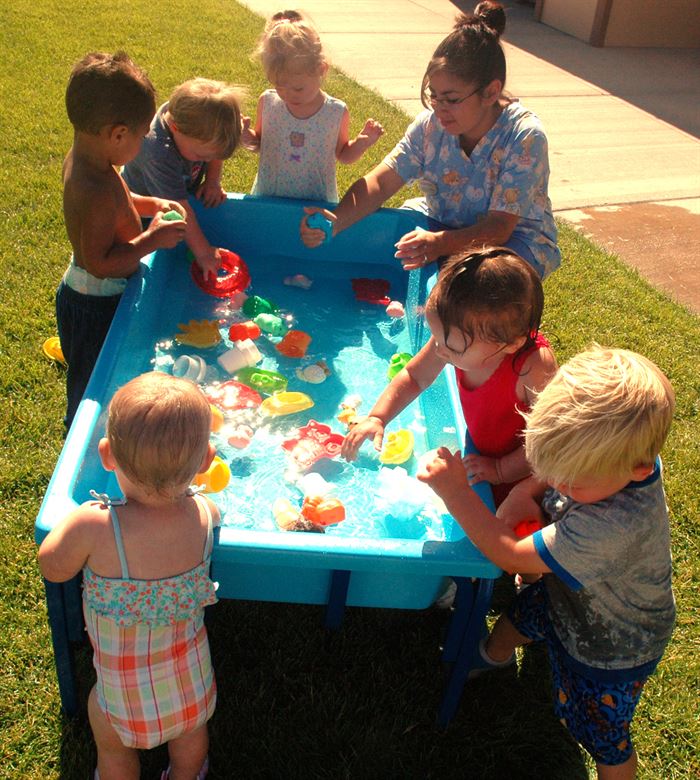
Reducing the Risk of Drowning
Reduce water hazards and prevent access to water
- Safety precautions must be taken to keep any water in the child care environment as risk-free as possible.
- Any body of water poses a threat and young children can drown in as little as one inch of water,
- The indoor and outdoor environments should be thoroughly screened to detect hazards that may lead to the risk of drowning
Promote safe behaviours
- Because children move quickly, are curious and do not understand their physical abilities, they must be watched carefully around even small bodies of water.
- The majority of drownings occur within a surprisingly short period of time.
- Never, ever, leave a child alone, even for a moment, when there is a body of water in the environment.
- When near water, always reinforce safety for the children.
- Plan water play when children are the least tired and most alert.
- Teach children safe practices for swimming and playing in the water.
- Have a telephone within easy reach at all times.
- Teach children water safety behaviours:
- Do not run, push or play around swimming areas.
- Do not swim with anything in your mouth.
- Do not swim in very cold water because it increases the risk of drowning.
- Look out for other children who might be in danger.
- Do not go near a pool unless supervised.
- Do not scream for help unless you mean it.
- Do not roughhouse in the water.[44]
Learn proper response if there is a water emergency and act immediately
- Pull the child from the water and place the child on his/her back.
- Check for breathing, and clear mouth and nose of any obstructions.
- Get another adult to call for emergency help.
- Begin rescue breathing or CPR as needed until the child is revived or help arrives.
Preventing Drownings
- Never leave a child alone in or near any body of water (tub, wading pool, shower, pool, water table or even a bucket).
- Always provide careful, direct and constant supervision of young children if there is a body of water present in the environment.
- Never expect swimming instruction to eliminate the risk of drowning in children.
- Supervise children in the water even if they are wearing flotation devices. These devices are not substitutes for constant supervision.
- Any hazard should be enclosed with a fence that is at least five feet tall and not easy to climb. A door or sliding glass door is not a safe substitute for a fence.
- Gates should have locks that are at least 55 inches high and self-closing. Keep gate keys in a safe place away from children.
- Never leave pool covers partially in place because children can become trapped beneath them. Pool covers are not a substitute for fencing.
- Keep chairs, tables and climbing equipment away from pool fences to prevent children from climbing over the fence into the pool.
- Learn CPR and keep rescue equipment at the poolside, including a life preserver, shepherd’s crook and cordless telephone to call 9-1-1.
- If a portable wading pool is used in child care (although it is not recommended), it should be filled with water, used immediately, drained and put away as soon as children leave the pool.
- Never leave infants or children unattended around five-gallon buckets containing even a small amount of liquid. Empty buckets when not in use.
- Children with seizure disorders are particularly vulnerable to drowning. Know your children’s medical history.
Preventing Poisoning Outdoors
This topic was covered in Chapter 3, but it is important to note that poisonous materials are also found outdoors, including some of the plants in Table 3.8.
To review the reading on Poisoning click here
Table 3.8 Poisonous Plants [62]
| Common Name | Botanical Name |
| Azalea, rhododendron | Rhododendron |
| Caladium | Caladium |
| Castor bean | Ricinis communis |
| Daffodil | Narcissus |
| Deadly nightshade | Atropa belladonna |
| Dumbcane | Dieffenbachia |
| Elephant Ear | Colocasia esculenta |
| Foxglove | Digitalis purpurea |
| Fruit pits and seeds | contain cyanogenic glycosides |
| Holly | Ilex |
| Iris | Iris |
| Jerusalem cherry | Solanum pseudocapsicum |
| Jimson weed | Datura stramonium |
| Lantana | Lantana camara |
| Lily-of-the-valley | Convalleria majalis |
| Mayapple | Podophyllum peltatum |
| Mistletoe | Viscum album |
| Morning glory | Ipomoea |
| Mountain laurel | Kalmia iatifolia |
| Nightshade | Salanum spp. |
| Oleander | Nerium oleander |
| Peace lily | Spathiphyllum |
| Philodendron | Philodendron |
| Pokeweed | Phytolacca americana |
| Pothos | Epipremnum aureum |
| Yew | Taxus |
Storing Toys, and Materials Safely
In order to protect toys, materials, and equipment from the elements, they should be safely stored when not in use. Keep storage areas clean and dry to prevent mould and infestations of insects, spiders, rodents, or other pests.
Child Care Licensee Manual –section 59 outdoor play area – the best practice, suggests that “…storage structures will be deducted from the outdoor play space measurements before calculating the required area per licensed child care space.
Pedestrian Safety

Each year for more than a decade, more than 700 children have died from injuries sustained while walking, over 500 of these in traffic. Although the fatality rate has declined somewhat during this period, it could be attributable to improvements in pre-hospital and emergency medical care or to a decline in walking as a mode of transportation. As we want children (and their educators and families) to get out and walk for both health reasons and for opportunities to explore and learn about their communities, we must make sure that they have a safe environment in which to do so.
Children under 10 should always have adult supervision. Children under the age of 9 do not have the skills necessary to safely cross the street for the following reasons:
- Vision – a child’s peripheral vision is still developing and they may not see cars coming.
- Hearing – children are unable to detect the location or direction of sound
- Size – Due to their small size, it is hard for drivers to see them
- Cognitive Development – Children are not able to determine the speed of an oncoming vehicle.
- Perception – Children often think if they can see the driver then the driver sees them. [62]
Check out all the resources that the Saskatchewan Prevention Institute has on safety.


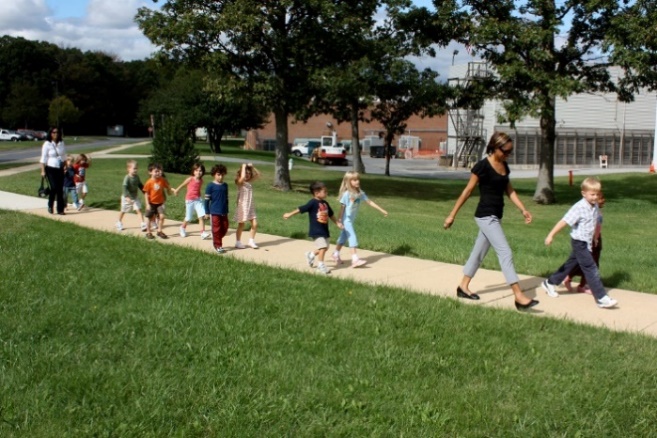
Teaching Children about Pedestrian Safety
Before going on a walk, teachers should talk to children about the safety practices that they will be using (see Table 4.7). Children need close adult supervision and proximity while walking because they may do the unexpected (like suddenly dart off the sidewalk).[46]
| Always walk on the sidewalk (if there is one). |
| If there is no sidewalk, walk facing traffic. |
| Be safe and be seen (bright clothing during the day, lights and reflectors at night). |
| Walk safely. Don’t run, don’t push or roughhouse. Be aware and don’t let toys distract you. |
| Watch for cars pulling in and out of driveways. Make sure drivers make eye contact with you. |
Teaching Children About Crossing Street
When it is time to cross the street, show children a good place to safely cross the street. Explain how to safely cross the street (see Figure 4.13). If there is a button at the crosswalk, have them push it.[49]
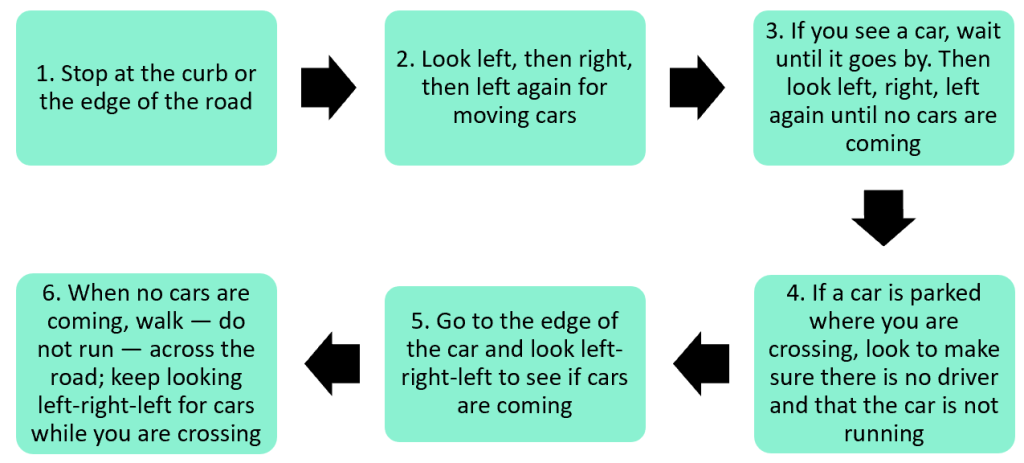
Motor Vehicle Safety
Motor vehicle injuries are a leading cause of death among children, but many of these deaths can be prevented.
- One CDC study found that, in one year, more than 618,000 children ages 0-12 rode in vehicles without the use of a child safety seat or booster seat or a seat belt at least some of the time.
- Statistics show that seatbelts can decrease the chances of being seriously injured in a traffic crash by as much as 50%.
- In 2019, there were 71 children 6 years of age or younger injured and 1 killed while riding in a vehicle.
- 5 of those children were not restrained or were restrained improperly. In addition, 12 of those children were wearing a seatbelt that may have been inappropriate for them.[51]
Safely Transporting Children
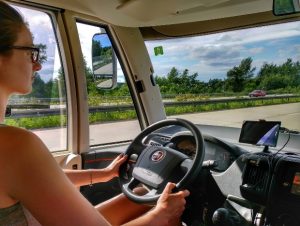
Child Care Regulations and the Transportation of Children
Section 83(b)
When transporting children from a child care facility, in Saskatchewan, the driver must have liability coverage with respect to the transportation of children in a motor vehicle. (Child Care Regulations 2015, Section 38b) [62]. The liability coverage must include both comprehensive general liability and personal injury coverage.
Section 54
Appropriate children restraints are used when transporting children, in accordance with SGI regulations (Child Care Regulations 2015, Section 54).
Excursions or off-site trips are an important part of any early learning program and it provides children with a multitude of early learning experiences. Early learning centres have a responsibility to create policies and procedures to keep children safe during an excursion or off-site activity. With regard to transportation safety, early learning centers need to make sure that they:
- Follow all provincial/territorial/municipal transportation laws and child care regulations
- Develop a written policy clearly stating transportation rules and responsibilities
- Ensure staff, parents, and children understand the importance of transportation safety[53]
General Transporation rules
- Ensure child restraints used are approved safety seats and/or safety belts.
- Secure each child and adult in their own safety seat or belt.
- Conduct a five-minute check to ensure the vehicle is working well and safe.
- Ensure children or adults are never transported in cargo areas.
- Never leave children alone inside or near a vehicle.
- Keep sharp or heavy objects in the trunk.
- Load and unload young children only when the vehicle is pulled up to the curb, side of the road or in a driveway, releasing them only to an authorized adult.
- Ensure children keep their arms or heads inside the vehicle.
- Don’t give children food or drink during transport.
- Place all hard objects, such as lunch boxes, on the floor.
- Ensure all fingers and feet are inside the vehicle before closing doors.
- Ensure all doors are locked, using safety locks if available.
- Remind children of the rules before driving the vehicle.
- Prepare activities like songs.
- Ensure all vehicles used for transporting children meet provincial Motor Vehicles Act requirements.
- Ensure the driver has a valid driver’s license for that class of vehicle.
- The interior of vehicles used to transport children for field trips and off-site activities should be maintained at a temperature comfortable for children.
- All vehicles should be locked when not in use.
- Headcounts of children should be taken before and after transporting to prevent a child from being left in a vehicle
- Children should never be left in a vehicle unattended.[54]
- A licensed driver transporting children should be trained in safety practices and if alone, have CPR and first aid training.
- They should have a safe driving record and their license should authorize them to drive the type of vehicle being driven.[55]
Hot Car Warning!

“Never leave children in a car or in another closed motor vehicle. The temperature inside the car can quickly become much higher than the outside temperature—a car can heat up about 19 degrees in as little as 10 minutes and continue rising to temperatures that cause death.”[56] |
Car Seats
When children are driven in a motor vehicle other than a bus, all children should be transported only if they are restrained in a developmentally appropriate car safety seat, booster seat, seat belt, or harness that is suited to the child’s weight and age in accordance with Provincial laws and regulations. The child should be securely fastened, according to the manufacturer’s instructions. The child passenger restraint system should meet motor vehicle safety standards. Child passenger restraint systems should be installed and used in accordance with the manufacturer’s instructions and should be secured in back seats only.
Car safety seats should be replaced if:
- they have been recalled – check Health Canada’s Child car seat safety alerts
- they are past the manufacturer’s “date of use” expiration date or have been involved in a crash
Video – Care Seat Safety Requirements
In this video, you will learn what is a legal and safe care seat. The video also explains how to read the labels on a car seat to determine if they are legal to use in Canada. Finally, you will learn about their expiry date – YES, car seats have an expiry date!
Buckling children in age- and size-appropriate car seats, booster seats, and seat belts reduces the risk of serious and fatal injuries:
- Car seat use reduces the risk of injury in a crash by 71-82% for children when compared to seat belt use alone.
- Booster seat use reduces the risk for serious injury by 45% for children aged 4–8 years when compared with seat belt use alone.
- For older children and adults, seat belt use reduces the risk of death and serious injury by approximately half.[57]
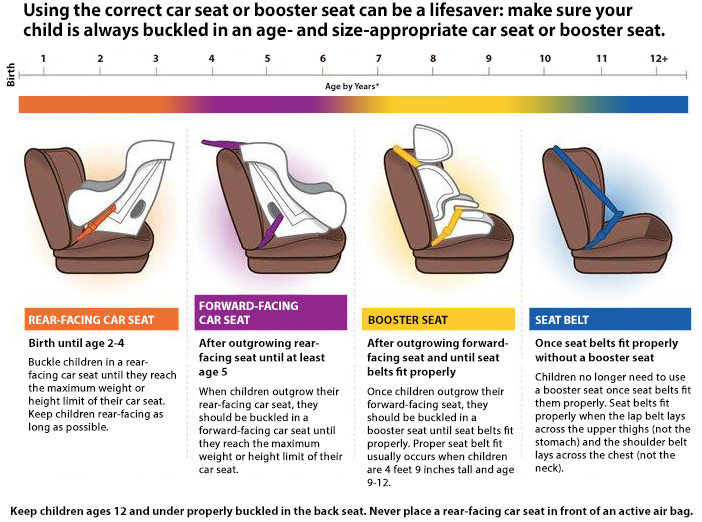
Video – Stages of Care Seats
The video below explains the different stages of the car seat.
Passenger Safety in Motor Vehicles
Video – Correctly Installing Rear-facing Car Seats.
The following two videos show you how to install rear-facing infant car seats. The second video focuses on how to install the base correctly.
Video – Correctly Installing Booster seats
Video – Correctly Installing High Back Booster Seats
Tips for Safe Field Trips
Early care and education programs can be enriched through carefully planned field trips. It is important that the destination be appropriate for the age and developmental level of each child that will be attending. Any special arrangements needed to make sure that all children can safely be included should be made ahead of time.
All staff and background-checked volunteers who will be attending should be made familiar with the travel plans, the field trip location, the rules, and their responsibilities. The children should also be prepared for the trip. Teachers can review and practice safety precautions and emergency procedures.
Families should be made aware of the field trip and provide consent for their child to attend. Emergency information for every child should be kept with staff off-site at all times. An accurate list of all children in attendance must be kept as well (at the field trip destination and at the school/center).
Adults should be assigned small groups of children. All adults should be made aware of the chosen regrouping location and checkpoints. Information is also provided in Chapter 6 about preventing lost children on field trips.[59]
Summary
Safe, outdoor play is vital to children’s health and well-being. Environments that are well designed, with age-appropriate, hazard-free equipment, impact-absorbing surfaces, and use zones around equipment will protect children from many injuries. Supervising children and actively monitoring the outdoor space are also key to preventing injuries. Having knowledge about the weather, implementing sun safety practices, protecting children from insects, following safe practices around water play, and storing toys safely is also important for children’s safety. When going off-site (and during drop-off and pick-up times), it’s important to remember pedestrian safety and how to safely transport children in motor vehicles.
|
Resources for Further Exploration · Safe Kids Worldwide: https://www.safekids.org/ · National Recreation and Park Association: https://www.nrpa.org/ · National Program for Playground Safety: https://playgroundsafety.org/ · Public Playground Safety Handbook by the Consumer Product Safety Commission: https://www.cpsc.gov/s3fs-public/325.pdf · Child Care Weather Watch: https://idph.iowa.gov/Portals/1/Files/HCCI/weatherwatch.pdf · Sun Safety for Schools: https://www.cdc.gov/cancer/skin/basic_info/sun-safety-tips-schools.htm · Shade Planning for America’s Schools: https://www.cdc.gov/cancer/skin/pdf/shade_planning.pdf · Child Passenger Safety: https://www.cdc.gov/motorvehiclesafety/child_passenger_safety/index.html
|
References
- Playgrounds! By the Office of Head Start is in the public domain. ↵
- Image is in the public domain. ↵
- Canadian Public Health Association (2019) Playground injuries. Retrieved from https://www.cpha.ca/playground-injuries ↵
- Play Power Canada (2019). Guide to Maintaining Your Playground Throughout the Seasons. Retrieved https://playpowercanada.ca/blog/how-to-maintain-your-playground-throughout-the-year/. ↵
- Saskatchewan Prevention Institute. (2014). Facts on: Playground Safety. Retrieved from https://skprevention.ca/safety/playground-safety/ ↵
- Playgrounds! By the Office of Head Start is in the public domain. ↵
- Public Playground Safety Handbook by the U.S. Consumer Product Safety Commission is in the public domain. ↵
- Image by veryhighfreqencydesign is in the public domain. ↵
- Sheung Ning Playground Walking Tiles by Prosperity Horizons is licensed under CC BY-SA 4.0. ↵
- Playgrounds! By the Office of Head Start is in the public domain. ↵
- Gravel Texture Pebble by Selrond is in the public domain. ↵
- Spreading Rubber Mulch on Playground by VSPYCC is licensed under CC BY 2.0. ↵
- A view of river sand by Thamizhpparithi Maari is licensed under CC BY-SA 3.0. ↵
- Gfp-wood-chips by Yinan Chen is in the public domain. ↵
- Playgrounds! By the Office of Head Start is in the public domain. ↵
- Playgrounds! By the Office of Head Start is in the public domain. ↵
- Public Playground Safety Handbook by the U.S. Consumer Product Safety Commission is in the public domain. ↵
- Public Playground Safety Handbook by the U.S. Consumer Product Safety Commission is in the public domain. ↵
- Public Playground Safety Handbook by the U.S. Consumer Product Safety Commission is in the public domain. ↵
- Public Playground Safety Handbook by the U.S. Consumer Product Safety Commission is in the public domain. ↵
- Public Playground Safety Handbook by the U.S. Consumer Product Safety Commission is in the public domain. ↵
- Public Playground Safety Handbook by the U.S. Consumer Product Safety Commission is in the public domain. ↵
- Public Playground Safety Handbook by the U.S. Consumer Product Safety Commission is in the public domain. ↵
- Summer Safety Tips for Early Care and Education Programs by the Office of Head Start is in the public domain. ↵
- Active for live. (2020). How to choose the right size and type of helmet for your child Retrieved from https://activeforlife.com/choose-right-helmet-for-your-child/ ↵
- Seattle Children’s Hospital. (2018). Bike and Multi-Sport Helments: Quick-fit Check. Retrieved from https://www.seattlechildrens.org/pdf/CE222.pdf ↵
- Brain Waves - Helmet Fitting Activity, Parachute, Paracute.ca ↵
- Active for live. (2020). How to choose the right size and type of helmet for your child Retrieved from https://activeforlife.com/choose-right-helmet-for-your-child/ ↵
- Center for Family Involvement. (2018). Collecting Data Using a Task Analysis. Retrieved from https://vimeo.com/281486327. ↵
- Playgrounds! By the Office of Head Start is in the public domain. ↵
- Public Playground Safety Handbook by the U.S. Consumer Product Safety Commission is in the public domain. ↵
- Caring for Kids. (N/A). Sun Safety. Retrieved from https://caringforkids.cps.ca/handouts/safety-and-injury-prevention/sun_safety#:~:text=When%20possible%2C%20stay%20indoors%20or,10%20a.m.%20to%202%20p.m.&text=Always%20protect%20babies%20from%20the,they%20are%20wearing%20a%20hat. ↵
- Summer Safety Tips for Early Care and Education Programs by the Office of Head Start is in the public domain. ↵
- Environment Canada's Humidex Comfort Ratings, Work Safe Saskatchewan ↵
- Safe Kids Worldwide. (2020). Risk Areas We Work In. Retrieved from https://www.safekids.org/preventing-heatstroke ↵
- Environment Canada. (2020). Keeping Children Cool: Protect Your Children From Extream Heat. Retrieved from https://www.canada.ca/content/dam/hc-sc/documents/services/publications/healthy-living/keep-children-cool-extreme-heat/extreme-heat-brochure-keep-children-cool-en.pdf ↵
- American Academy of Pediatrics. (2020). Protecting Children from Extreme Heat: Information for Parents. Retrieved from https://www.healthychildren.org/English/safety-prevention/at-home/Pages/Protecting-Children-from-Extreme-Heat-Information-for-Parents.aspx ↵
- Keep Children Cool: Protect Your Child from Extream Heat, Health Canada, Canada.ca, in the public domain ↵
- UV index, heat and wind chill products, Government of Canada, in the public domain ↵
- Cold Weather Safety from the Office of Head Start is in the public domain. ↵
- UV index, heat and wind chill products, Government of Canada, in the public domain ↵
- Tick Bite: What to Do by the Centers for Disease Control and Prevention is in the public domain ↵
- Splish Splashing and Having Fun! By Lorna Gutierrez is in the public domain. ↵
- California Childcare Health Program. (n.d.). Prevent Drowning. Retrieved from https://cchp.ucsf.edu/sites/g/files/tkssra181/f/drownen081803_adr.pdf ↵
- We don’t need buses for our class field trips by Woodleywonderworks is licensed under CC BY 2.0 ↵
- Healthy Families BC. (2016). Pedestrian Safety Tips to Teach Kids. Retrieved from: https://www.healthyfamiliesbc.ca/home/blog/pedestrian-safety-tips-teach-kids ↵
- A Kid’s Guide to Safe Walking by the NHTSA is in the public domain. ↵
- Lesson 1: Walking Safely Near Traffic by the NHTSA is in the public domain. ↵
- Healthy Families BC. (2016). Pedestrian Safety Tips to Teach Kids. Retrieved from: https://www.healthyfamiliesbc.ca/home/blog/pedestrian-safety-tips-teach-kids ↵
- A Kid’s Guide to Safe Walking by the NHTSA is in the public domain. ↵
- Saskatchewan Government Insurance. (2023). https://sgi.sk.ca/safety-stats#child-car-seats ↵
- Image by Glavo is in the public domain. ↵
- Saskatchewan Polytechnic. (2023). ECE 142 Health, Safety and Nutrition: Transportation Safety. https://online.saskpolytech.ca/d2l/le/content/303017/viewContent/11260535/View ↵
- Interior Temperature of Vehicles by the Office of Head Start is in the public domain. ↵
- Qualifications for Drivers by the Office of Head Start is in the public domain. ↵
- American Academy of Pediatrics. (2020). Protecting Children from Extreme Heat: Information for Parents. Retrieved from https://www.healthychildren.org/English/safety-prevention/at-home/Pages/Protecting-Children-from-Extreme-Heat-Information-for-Parents.aspx ↵
- Child Passenger Safety: Get the Facts by the CDC is in the public domain ↵
- Image by the CDC is in the public domain ↵
- New Jersey Department of Education. (2019). Preschool Guidance and Materials. Retrieved from https://www.nj.gov/education/ece/psguide/trip.htm ↵






